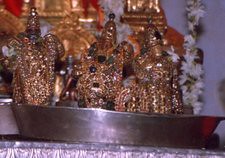Brahma Mimamsa Shastra !
Bramha sutras Are known as Bramha Mimamsa Shastra . Lord NARAYANA as Vedavyasa himself has composed BRAMHA SUTRAS . WHY?
Vedas are infinite ! what does it mean vedas are infinite ?
a contemplation on the issue will bring to light certain mind-boggling tenets … what are they …?
To delve deeply we must understand what are vedas ? they are group of naturally ordered sequence of aksharas . what are aksharas ? kshara is perishable commodity … akshara is imperishable commodity ! so its existence in universe is TRUTH .. as it is imperishable it exists naturally and is indestructible … so it is visible too .. one who sees this is known as RISHI …
Now a rishi is someone who has realised this imperishable sequence of aksharas and has visualised it and is able to recite it at will [as he sees it regularly he can read it too in space …. so a readily accessible concept for him ] …
Now every person be it RISHI or otherwise has a limitation and hence cannot be knowing entire Infinite VEDAS or might have realised entire infinite Vedas …
but according to the sadhana carried over by rishis each might be knowing a specialised VEDA thus may be unique in his exposition of knowledge .. Each Rishi is exponent of specific unique mysterious knowledge …
In KRUTAYUGA the path showed by VEDAS was still non wavering and uniform all through the UNIVERSE …that means each exalted soul was engaged in his own pursuit of excellence and meeting such people always resulted in new exposition of new concept .. World was Ideal …
In treta the wavering of path of VEDAS occurred due to downfall of one leg of DHARMA ..and in Dwapara yuga it experienced a jolt .. by the end of DWAPARA yuga it extinguished completely … People say it was chiefly due to the curse of sage GAUTAM //
What happened due to the curse ? Failure to recollect verses was experienced …
SO vedas as it was present in the form of lineages of various rishis in various parts of the world ..suffered a discontinuity …and vedas as it was distributed and separated in various places in the form of few enlightened souls .. stood the risk of annihilation …
Here at this point LORD VEDAVYASA manifested himself making the SATYATI and PARASHAR episode as excuse [nimitta ] … and reestablished vedic way of life by dividing VEDAS into four 10 25 100 1000 parts and distributed them among the rishis and munis and to practise ….
Yet when these were practised .. rishis and munis and learned scholars could not understand the meaning of Vedas [ as in limited distributed learning ] .. SO in order to make people understand the meaning of vedas ,rather to enumerate the pointers to understanding of Vedas LOrd VEDAVYASA wrote BRAMHA SUTRAS ..
In the first part of Kaliyuga for few thousand years in NAIMISHARANYA sages propagated them in strict adherence to Sutras … slowly as kaliyuga progressed intellect of human decreased with increase in sins .. and slowly the disappearance of sages made it further difficult for common learned people to decipher the meaning of the SUTRAS ..
Upon that in came onslaught of various different paths of avedic culture which gained strength … In the mixup of various philosophies … People came up with various interpretations of SUTRAS to suit their own philosophy … and within no time 21 various interpretations of SUTRAS were in vogue making it very difficult for scholars to decipher the real meaning of VEDAS ..
At this point of time ACHARYA MADHVA gave his BHASHYA commentary to the SUTRAS .. the earlier commentaries 21 in number were not acceptable to the original SUTARKAAR Shri VEDAVYASA as it did not reflect even remotely the intent of the LORD ..the 22nd commentary by SRIMADANANDA teertha not only reflected the original intent of LORD but also simplified it for the scholars to come .
ACHARYA has incidentally written four granthas as vyakhyana for the BRAMHASUTRA .. 1.BRASUTRA BHASHYA 2.BRAMHASUTRAANUVYAKHYANA 3. BRAMHASUTRA NYAYAVIVARANA 4 BRAMHASUTRA ANUBHASHYA
In an elaborate and precise manner SUTRA BHASHYA has been written and then again ANUVYAKHYANA to crush the apavyakhyana of the SUTRAS to help the sajjanas … However to understand the logic employed in these granthas to uphold the real meaning of VEDAS .. it required a mammoth skill and hence to help such exercise and ease them ACHARYA collected various logics and inferences and pramanas in another exposition namely NYAYAVIVARANA ..
To concisely bring them to memory of the sadhaka he composed a small reference text known as ANUBHASHYA .. this is only for the namesake ANUBHASHYA but actually is a magnum opus of ACHARYA exhibiting his infinite skill in comprising the meanings of many a sutras in one single word .. each sutra nd set of sutras have been just explained in a word in ANUBHASHYA .. to understand them succeeding ACHARYAS like JAYATEERTHA and RAGHAVENDRA swamiji have written many books .. one among them being TATVA MANJARI of RAGHAVENDRA SWAMY only through which we understand the beauty and unfathomable knowledge of ACHARYA MADHVA in representing various concepts in single word .. just like KRISHNA SHOWED the whole creation to his mother yashoda in his small mouth .. so also ACHARYA compressed the entire infinite VEDIC knowledge into concise ANUBHASHYA …easy for parayana ..
BRAMHA Sutra has 564 sutras grouped into 223 adhikaranas each propounding a certain aspect of VEDA ,..
Some adhikarana have only one Sutra and some have two or three or more …
these adhikarnas are divided into Four ADHYAYAS and each Adhyaya is further divided into four padas .In all making 16 padas ..
In the first pada of the first Chapter .. which is known as SAMANVAYA adhyaya .. a samanvaya has been made with respect to all words occurring in nature as representing LORD .. ie it has been made samanvaya that all words convey only GOD … and he is PARIPOORNA …
There will be eight types of words that would require samanvaya
- the words which are different from those that represent GOD and convey names [namatmak ]
- the words which are expressions of form gender etc and in reference in world generally not representing GOD [ lingatamak]
- words those are nounal and are used in reference to GOD as well as others simultaneously
- words that are ref to form , gender etc lingatmak but simultaneously used for both GOD and others
- namatmak words different from above four types
- lingatmak words different from above four types
- namatmak words representing only GOD
- lingatmak words representing only GOD
- the first pada of first chapter deals with point 1
- the second pada deals with point 2 ie type 2
- the third pada deals with type 3 and 4
- the fourth deals with type 5 and 6
as 7 and 8 types do not require any samanvaya they are not covered ..
In ADHYAYA 2 .. there is khandana [ refutation ] of the argument that there is contradiction in VEDAS as regards to SUPREMACY of LORD with respect to time .,inference ,and sentences in VEDAS are contradictory …
this is known as AVIRODHADHYAYA as it shows there is no difference in the vedic verses as per the meaning they convey .. all the verses convey SUPREMACY of LORD and do not contradict ..with respect to creation of universe and auspiciousness of LORD
- in the first pada of this adhyaya is shown avirodha with respect to yukti
- in the second pada avirodha wrt time [darshan ] is established
- in the third pada the diferrences in SHRUTI vakyas seemingly contradictory have been reconciled
- in the fourth pada nyayopet yuktisahit shruti avirodha has been established
the Third ADHYAYA is known as sadhanaadhyaya ..
In the first adhyaya Lord is established as SUPREME .. in the second any objection raised by various thought processes have been refuted .. so a scholar reading these two chapters is confirmed with the knowledge of VISHNU SARVOTTAMATVA .. then what next ?
SO different sadhana are enumerated to facilitate BRAMHA JIGNYASA in the third adhyaya ..
- in the first pada VAIRAGYA has been explained
- in the second pada the most instrumental in VAIRAGYA is BHAKTI is enumerated
- the subject matter of third pada is UPASANA which gives rise to BHAKTI
- the subject matter of fourth pada is APAROKSHA
the fourth ADHYAYA then elaborates once vairagya dawns with bhakti owing to upasana leading to APAROKSHA then what is the use of all this ? It explains the fruits of such exercise and is known as PHALADHYAYA
Bramhagyana when dawns it results into MOKSHA and its swaroopa is explained and path leading to it after aparoksha is also explained ..
- The first pada explains the result of KARMANAASH
- the second deals with deha laya of those who have achieved KARMAKSHAYA owing to gyana and BHOGA
- the third deals with place and path reached by the souls who leave through BRAMHANAADI or other naadi known as UTKRAMANA
- The fourth deals with achieving the PARABRAMHA through chaturmukha BRAMHA and BHOGA or enjoyments of MUKTA JEEVA …
In this way starting with ATHATO BRAMHA JIGNYASA … Bramha sutras instruct the scholars to inquire about the SUPREME as a vidhi and kartavya through its four adhyayas … and with SHRAVNA MANANA AND NIDHIDHYASANA forms of sadhana and acquiring SHAMA DAMA etc wealth adhikaari should aspire for MOKSHA which is result of BRAMHA JIGNYASA and it is a compulsory duty “avashya ” through steady meditation of BRAMHA Sutras BHASHYA and VYAKHYANA is the clear proclamation of BRAMHA MIMAMSA SHASTRA ..
krishnarpanamastu





Notes & comments